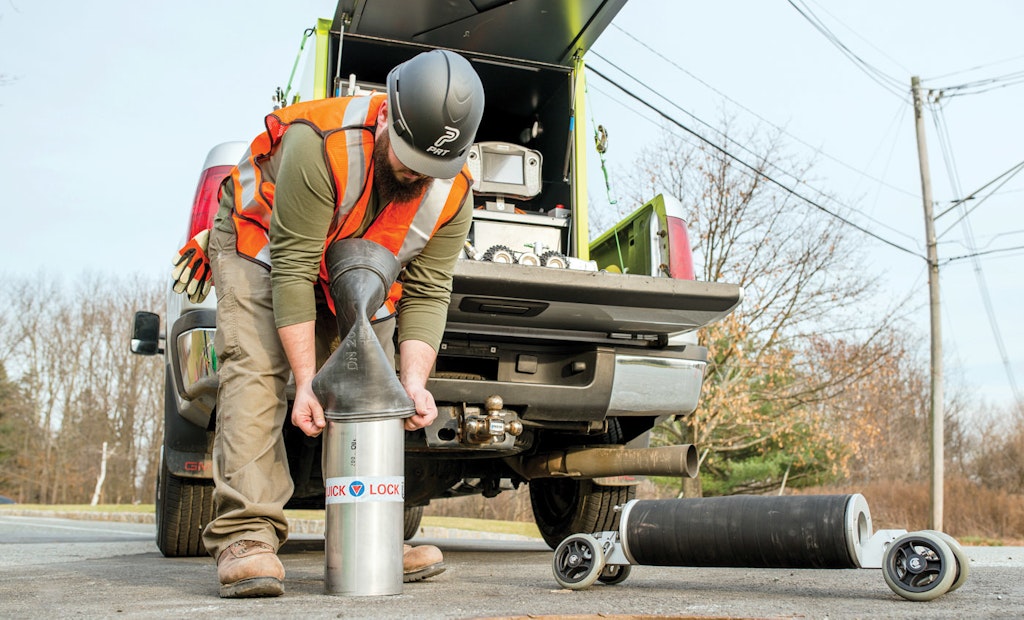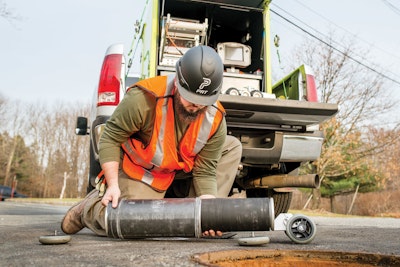
A rubber gasket slides down over the stainless steel Quick-Lock sleeve and then onto the packer. When everything is in position in the pipe, tiny gears in the ratchetlike lock system are clicked into place to compress the gasket between the host pipe and sleeve.
Interested in Relining/Rehab?
Get Relining/Rehab articles, news and videos right in your inbox! Sign up now.
Relining/Rehab + Get AlertsDuring frigid South Dakota winters, it’s difficult for crews at Hydro-Klean to use conventional felt CIPP systems to perform spot repairs in municipal sewer lines. Installations require a propane heater to cure the liner, plus the curing time might extend to five hours or more, which boosts labor expenses for customers.
“The other option is mixing the chemicals differently to shorten the curing time,” says Derrick Joens, who is based in Watertown, South Dakota, and is director of pipeline rehabilitation at the company. The company is headquartered in Des Moines, Iowa, and primarily does industrial cleaning and trenchless pipe rehabilitation in Iowa, Kansas, Minnesota, Missouri, Nebraska, North Dakota, South Dakota and Wisconsin. “But then you run the risk of the liner curing before you can get it in place.”
These days, however, Hydro-Klean crews do spot repairs year-round. And they do them in about 30 minutes to an hour since the business started using Quick-Lock sleeves, developed by Pipeline Renewal Technologies (an Envirosight company).
The adoption of Quick-Lock technology has generated a positive ripple effect throughout the company’s operations and finances. For example, along with increasing customer satisfaction through year-round repair capability, Joens says the company has seen a significant annual increase in gross revenue as crews keep working through the winter months.
Moreover, because crews work year-round, the company no longer has to jam an overwhelming amount of pent-up repair work into the short summer season — a situation that often forced the company to hand off work to competitors, just to keep customers happy.
“That hurts financially because emergency work always is more profitable than bid jobs,” Joens points out. “In addition, our backlog would get so long in the summer that we’d have to back off on bidding jobs. Now we can bid jobs year-round and still fit in emergency jobs.”
Overcome infiltration
Quick-Lock sleeves also enable crews to sidestep delays they used to encounter while trying to repair pipes during spring, when melting snow leads to sewer infiltration. “In years past, we’d have to patch the leaks and then wait, so there was a time delay,” Joens says.
“But even with infiltration, we can still install Quick-Lock sleeves in about an hour and then do mainline pipe lining the same day. Plus, we don’t have to plug off lines and do bypass pumping in order to work.”
Furthermore, because the company can now perform repairs year-round, it doesn’t lose employees who often used to leave during winter months because they didn’t get enough hours. “It really improves employee morale when they know they’ll have jobs all winter,” Joens says. “Plus, we don’t have to do as much training because there are fewer new guys coming in every year.”
There’s another benefit, too: Installing Quick-Lock sleeves requires only two employees and significantly less equipment. It’s also much faster and less cumbersome than wetting out felt CIPP patches.
“If you’re running only two service techs instead of four, the discount to customers is pretty significant,” he says.
Easy installation
The company typically uses Quick-Lock sleeves to fix only 8- to 24-inch-diameter pipes, but Pipeline Renewal Technologies can also custom-fabricate sleeves in odd pipe diameters. The system consists of three basic components: a gasket made from EPDM rubber; a stainless steel cylinder that features two circular, ratchetlike locking devices located inside the cylinder near each end; and a mobile, four-wheeled packer, which essentially is a pneumatic bladder used for installation. The packer gets pushed into position by a robotic camera. The packer comes in two sizes; they retail for about $6,000 and $14,000, respectively.
Joens says the installation process is pretty cut-and-dried. In a nutshell, here’s how it works: First pull the rubber gasket over the stainless steel cylinder; then slide the cylinder onto the packer. Connect an air compressor to the packer and inflate it to a point where it can hold the sleeve in place.
Then insert the robotic camera and the packer into the pipe and guide the sleeve into position. “Because the packer is pretty short, it’s easy to fit it into a manhole and place it in the pipe,” Joens says.
Next, inflate the packer to a predetermined pressure. As the bladder inflates, the sleeve expands to fit the host pipe. As it does so, tiny gears in the ratchetlike lock system keep clicking into place, compressing the rubber gasket tighter and tighter between the host pipe and the sleeve; the locking devices keep the sleeve from sliding back into its original position.
Then deflate and remove the bladder, leaving behind a sleeve firmly lodged inside the pipe. There’s a slight lip left on each end of the sleeve, but Joens says he’s never seen anything catch on it. If the pipe is eventually lined, the ends of the sleeve aren’t noticeable.
Almost any robotic camera will work as a towing device. Joens uses a camera made by CUES.
Because the sleeves are made from stainless steel, the Quick-Lock system offers the added benefit of providing structural support for failing pipeline segments, plus minimal diameter loss. For longer repairs, the Quick-Lock sleeves can be installed end to end in a series. But Joens says there’s a tipping point where it becomes more economical to line a pipe using CIPP technology.
While Quick-Lock fills a niche for certain applications, it will never completely replace CIPP patches. But Joens says the product is a great complement to CIPP technology, and to Hydro-Klean overall, in terms of increased revenue.
“I’d like to be the only guy using it,” he says. “But I’d highly recommend this product to other companies — as long as they don’t work in the Midwest.”






